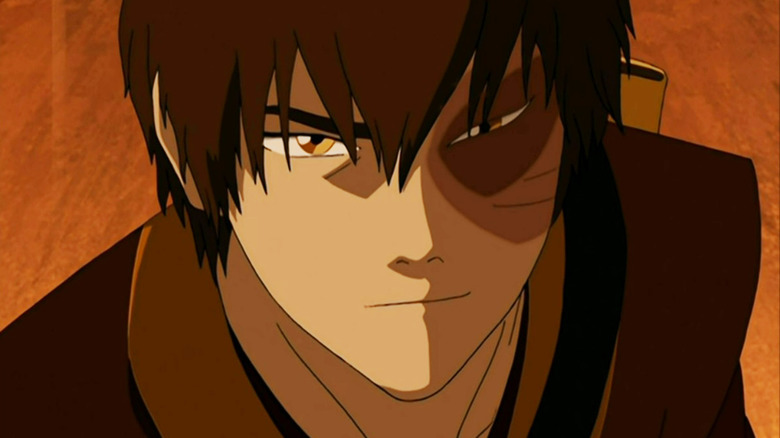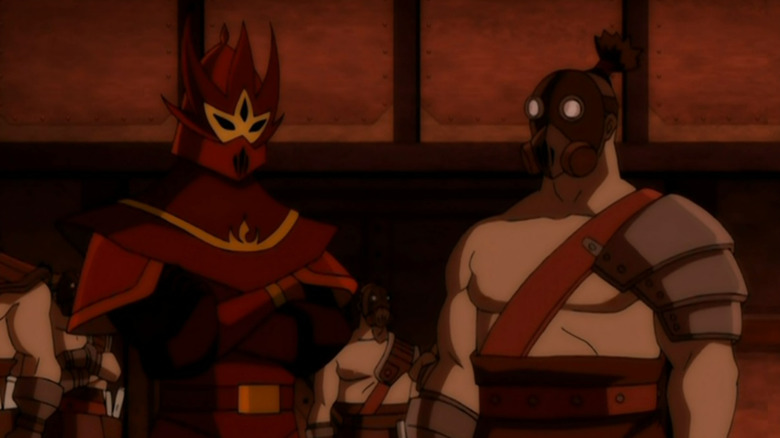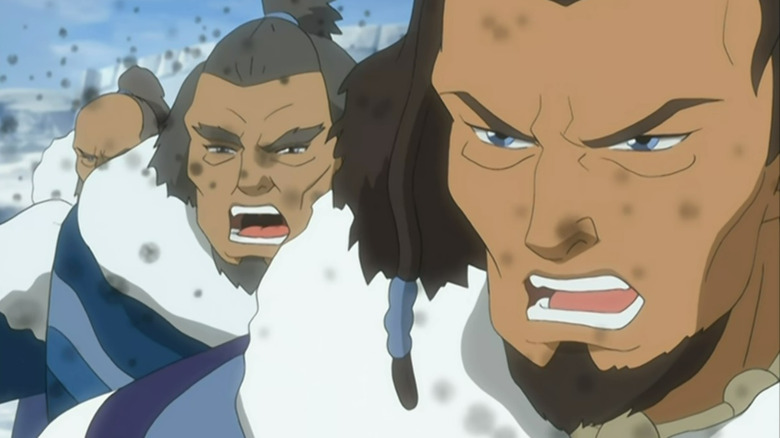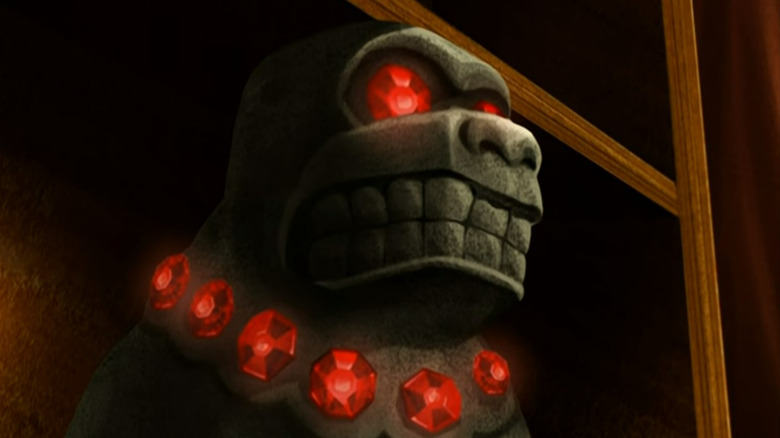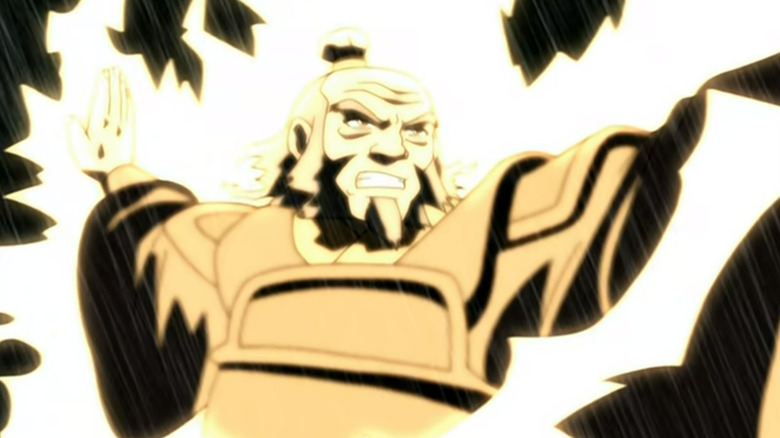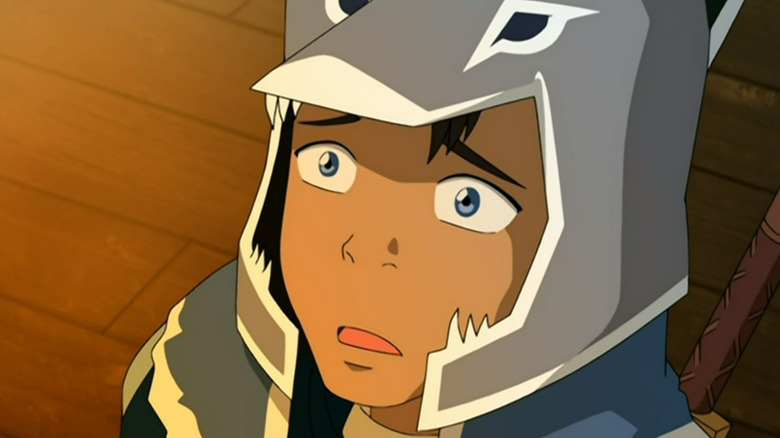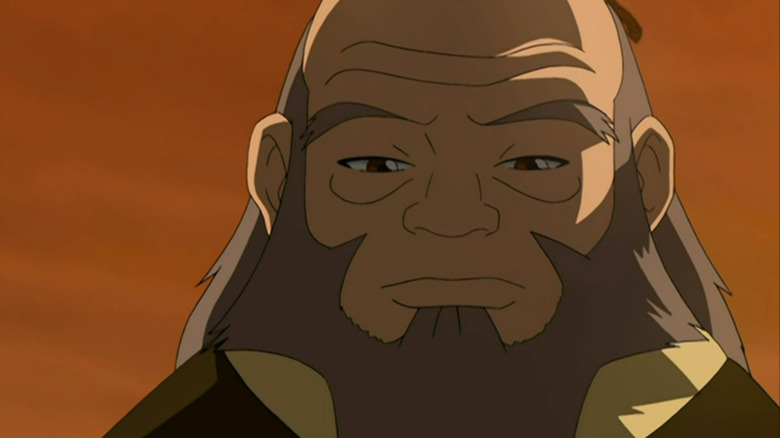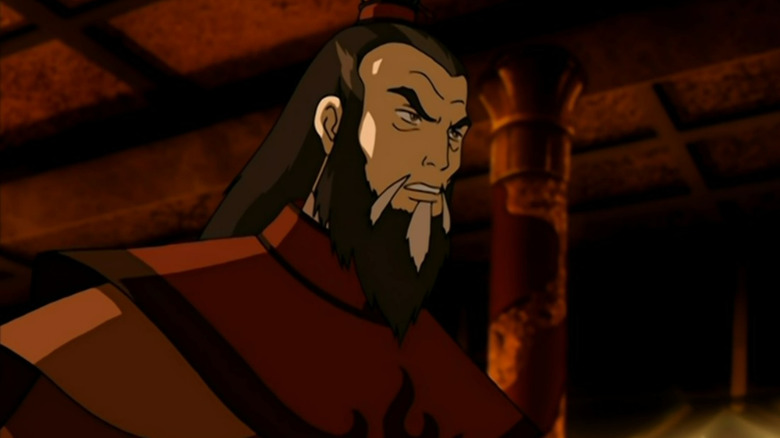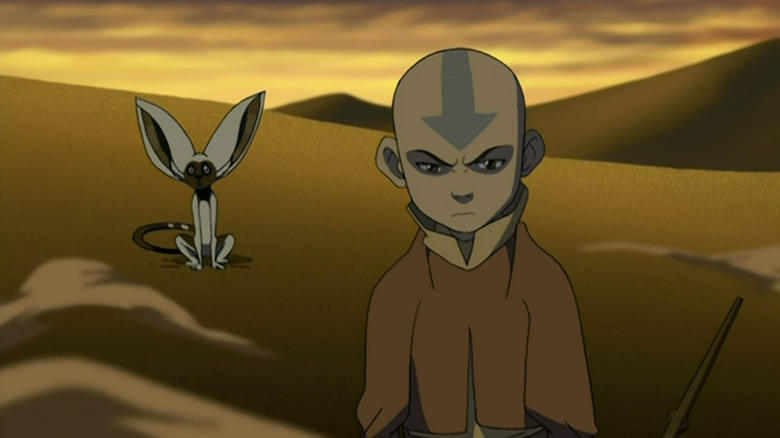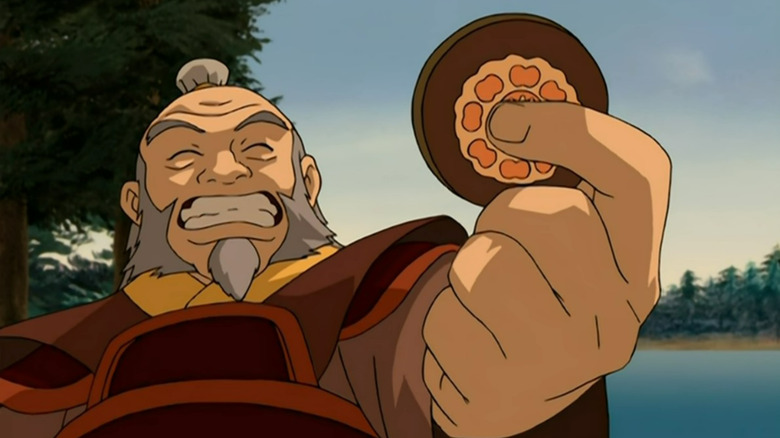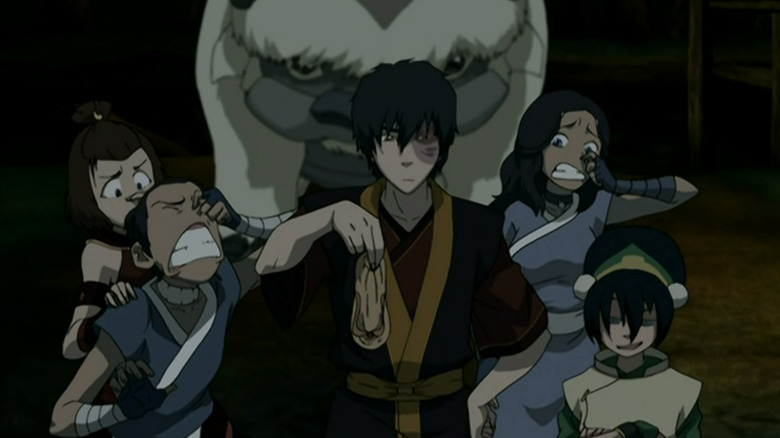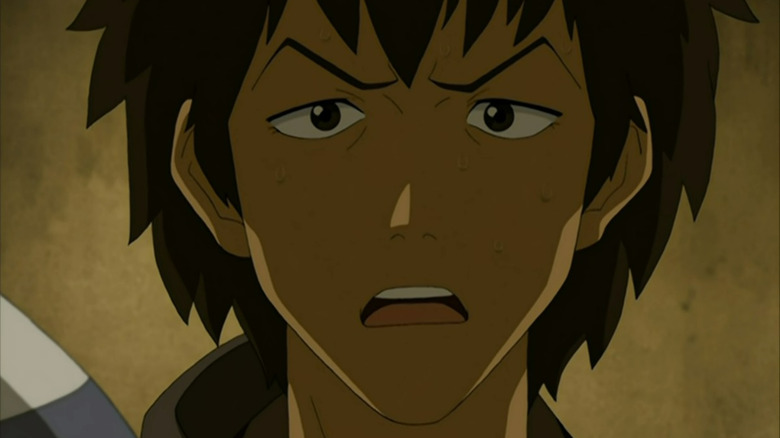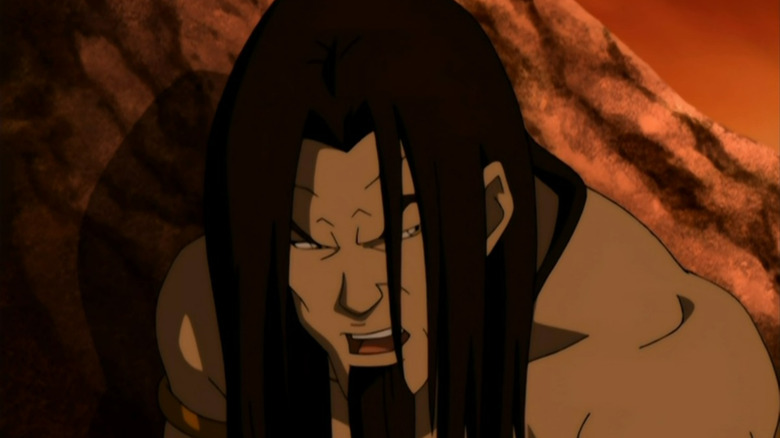Things You Only Notice In Avatar: The Last Airbender After You've Watched It More Than Once
"Avatar: The Last Airbender" is a show that keeps on giving long after your first viewing. Its fictional world has been expanded in the critically acclaimed sequel series "The Legend of Korra," an ongoing run of comics set after the events of the original show, and a number of prequel novels. All this subsequent material has stretched the story's timeline in both directions, and added important context to the franchise's cultures.
But even within the original series' confines, there are a lot of little details — both comical and dramatic — that are easy to miss your first time through. "Avatar: The Last Airbender" earned many accolades throughout its three-season run for its stellar animation, beautiful soundtrack, and killer voice acting. But the writing is at the core of what makes the series so great, and you can only properly appreciate it after watching it more than once. From Sokka's brilliance to the truth about the White Lotus, these are the things you only notice in "Avatar: The Last Airbender" after watching it multiple times.
There are so many dumb guards
Fictional soldiers, henchmen, and sundry other goons tend to stink at their jobs. Any random crew of meddlesome kids can quickly make them look like fools. But in "Avatar: The Last Airbender, this trope happens a staggering number of times. The show is positively brimming with dumb guards who are anything but qualified for their one job.
It doesn't take the show long to start throwing idiot henchmen at Aang and the gang. When the Avatar is first captured by Prince Zuko, the guards escorting him to his cell barely keep him contained for 30 seconds. Then, just a few episodes later, we meet a group of soldiers who think that lemurs are capable of earthbending. In Season 2, when the crew returns to the Earth Kingdom city of Omashu — now under Fire Nation control — they easily convince a group of dimwitted guards that they have a fake disease called pentapox, which ultimately leads to the entire city populace escaping. Season 3 includes bumbling Fire Nation soldiers like the ones in "The Beach," who are more interested in picking their toes than standing watch.
And then there are the awkward soldiers glimpsed in the series finale. For a moment, these dopes think their airship captain has asked everyone to assemble, in the midst of an attack ... to celebrate a crew member's birthday. At least they're voiced by the show's creators.
The true tragedy of the Southern Water Tribe
"Avatar: The Last Airbender" begins in the Southern Water Tribe, which is little more than a handful of homes inhabited by children and the elderly. As Katara soon explains, the tribe's warriors left years ago to help fight the Fire Nation. Season 3 introduces further context through flashbacks, which capture the brutal raids and massacres suffered by the Tribe earlier in the war. Long before the warriors left, the Tribe's waterbenders had all been captured or killed.
Going back to Season 1 with this extra knowledge makes the plight of the Southern Water Tribe even more dire. Sokka and Katara's father Hakoda faced an almost impossible decision after his wife was murdered in one of these raids: Stay put and likely see others meet the same fate, or leave the Tribe unprotected while trying to strike back against the enemy.
The comic series "Avatar: The Last Airbender — North and South" further reveals that the Southern Water Tribe has always been less centralized than the Northern Tribe. They've never been a militant nation, but due to this comparative weakness, their proximity to the Fire Nation, and the threat their bending inherently poses to imperialist firebenders, they became an inevitable target after the genocide of the airbenders came to a close.
The traveling monkey statue
"Avatar: The Last Airbender" boasts a very complex level of continuity. Throwaway lines and small details from seasons past are constantly referenced, like the unsettling monkey statue first seen in Season 1's "The Waterbending Scroll."
While shopping at a port, Aang, Sokka, and Katara board a pirate ship to peruse its collection of curios. Katara is particularly struck by a monkey statue studded with red gemstones, which almost seem to entrance her. Later on in the episode, Uncle Iroh is shown admiring the same statue and eventually purchasing it. Fast-forward to Season 3's "The Runaway" — an episode that premiered years later — and you can see the exact same statue amidst the piles of loot won by Toph and Sokka through their various scams. It's possible that the statue was confiscated when Zuko and Iroh's ship was taken by the Fire Navy in Season 1, and eventually made its way to Toph and Sokka's hoard. Or maybe, just maybe, the statue is actually cursed.
The monkey statue isn't the only continuity-rich detail in the series. In Season 1's "Imprisoned," Aang is shown trading an unnamed man some nuts for his hat. That same hat reappears multiple times; Aang often wears it around the Earth Kingdom to hide his arrow tattoos.
How Iroh learned to redirect lightning
Lightning redirection is one of the most important abilities in "Avatar: The Last Airbender," both because of its effectiveness against Ozai and Azula and because of its larger symbolism. It's a defensive firebending technique, which is inherently notable, but it also represents what it means to fight back. Zuko learns the technique from Iroh, and later uses it to stand up to both his father and sister.
When Iroh teaches Zuko to redirect lightning, he says he developed the technique by studying waterbenders. While this could be true, a second viewing of the show will show you what might be the actual first time Iroh uses this move. In Season 1's "The Storm," Zuko and Iroh's ship gets caught in a terrible squall. When a bolt of lightning strikes, Iroh steps in and performs a redirection, one whole season before he actually explains it.
After redirecting the bolt, Iroh looks shocked — and not just because of the lightning. In the "Avatar: The Last Airbender" timeline, lightning creation is an advanced technique only taught to the royal family, and redirection is Iroh's invention. In all likelihood, this is the first time Iroh actually uses the technique. It's also worth noting that his military career was focused in the Earth Kingdom, where he likely didn't encounter many waterbenders. Could Katara have been the main inspiration for the move that ultimately saves Zuko's life?
Sokka is an actual genius
Sokka fills many roles over the course of "Avatar: The Last Airbender." He's a comic relief character, a dour pessimist, and, as a non-bender, a sort of straight man to the superpowered members of Aang's gang. Occasionally, he describes himself as the regular one in the group. But those who've watched the show more than once will know that Sokka is anything but regular.
Sokka's technical and strategic abilities are pretty evident when watching the series for the first time. He's often referred to as the "plan guy" or the "idea guy," and indeed, his plans and ideas have a pretty high success rate. But it's only after coming back to the show that you realize just how brilliant Sokka truly is. He's the one who figures out how to make the hot air balloons work, leading (unfortunately) to the Fire Nation's development of their zeppelin fleet. He also invents submarines powered by waterbending and tanks powered by earthbending for the invasion of the Fire Nation during the solar eclipse. Sokka's the one who figures out how to destroy the drill in Ba Sing Se, and he devises the plan to take out the airship fleet during Sozin's Comet. Many of the technological advancements seen in "The Legend of Korra" are the direct result of Sokka's unique ingenuity.
The depths of Iroh's spirituality
Uncle Iroh embodies principles of balance and serenity, and tries his best throughout the series to guide Zuko toward the light. But there are a few moments throughout "Avatar: The Last Airbender" that hint at even greater spiritual attunement within Iroh, second only to the Avatar himself.
The first glimpse of this is in Season 1's "Winter Solstice, Part 1: The Spirit World." While lounging off ship, Iroh is captured by a group of Earth Kingdom soldiers. As he travels with them, he clearly sees the spirits of Aang and Avatar Roku fly overhead. No one else is able to see Aang in the Spirit World. For that matter, no one else in the rest of the show is able to see Spirit World beings in the physical realm. Later, Admiral Zhao mentions rumors that Iroh once journeyed to the Spirit World. Moreover, Iroh knows about Season 3's solar eclipse before it happens, despite never having received any information about it.
A lot of Iroh's life is still a mystery. We know he went missing after losing his son in the siege of Ba Sing Se, during which time he may have encountered the ancient Sun Warrior society and even traveled to the Spirit World. These details are up for debate, but the hints we do get help explain why he dwells in the Spirit World in "The Legend of Korra."
Aang's past lives are never totally right
As the Avatar, Aang is able to glean bits of wisdom by communing with his own past lives. He frequently consults with Avatar Roku, who directly preceded him in the reincarnation cycle. While these spiritual mentorship sessions often help, re-watching the show reveals just how often Aang's past lives are in the wrong.
Roku himself admits to screwing up and allowing Fire Lord Sozin, a lifelong friend, to start the Hundred Year War. Later, he encourages Aang to be more decisive than he was and kill Ozai — something that goes against Aang's moral code. In fact, every past life Aang asks for advice about Ozai tells him to kill the Fire Lord, even his fellow Air Nomad Yangchen. In the end, Aang is able to find a different way to stop Ozai's reign of terror without compromising his own values. If it were up to Avatar Kyoshi, best known for her overwhelming force, he definitely wouldn't have gotten off so easily.
The fallibility of Aang's past lives is important, because it makes them human. But there's another layer to it. As much as "Avatar: The Last Airbender" is a show about respecting tradition and legacy, it's also a show about staying true to yourself. It's important that Aang takes counsel from the previous Avatars, but it's equally important that he doesn't limit himself to what they tell him to do.
Season 2 is incredibly complex
Each season of "Avatar: The Last Airbender" serves a particular purpose. In addition to being tied to specific elements, they make up the show's traditional three-act structure. Season 1 establishes the world, while Season 3 brings all the long-term arcs to a head in an action-packed climax. But Season 2 is arguably the most complex and interesting part of "Avatar: The Last Airbender," and not just because it ends on a down note.
"Book 2," as it's styled, challenges a lot of Season 1's ideas. Though the Earth Kingdom is technically on Aang's side, they're revealed to be a lot more complicated than viewers previously thought. In the very first episode of Season 2, Aang encounters an Earth Kingdom general who wants to train him as a weapon. It's a harsh goal, but one the general believes is necessary to end the war. Then, the extended Ba Sing Se arc explores the Earth Kingdom capital's deep corruption, showing that villains can hide anywhere.
Even more notably dramatic is the intense fury Aang experiences in Season 2. After losing Appa to bandits, he falls into an enraged depression so severe, he kills animals when necessary. This is the only moment he breaks with his deep committment to nonviolence. Fortunately, Aang rises out of this season stronger than before.
The White Lotus is teased in Season 1
One of the biggest mysteries of "Avatar: The Last Airbender" concerns the Order of the White Lotus, a secret society that helps take back Ba Sing Se from the Fire Nation in the series finale. Iroh, Bumi, Piandao, Pakku, and Jeong Jeong are all members, though most of their affiliations are kept secret until "Sozin's Comet." The White Lotus first enters the story in the middle of Season 2, when Iroh and Zuko seek their help as refugees. But in fact, this secret society is actually alluded to much earlier.
In Season 1's "The Waterbending Scroll," Iroh forces Zuko to make a stop so he can purchase a new lotus tile. A serial Pai Sho shark, Iroh explains that he lost the game piece and needs a new one to be able to keep playing. Though he calls it a lotus tile rather than a white lotus tile, it clearly bears the society's symbol. This makes the way Iroh talks about the piece even more interesting.
When Zuko objects to the shopping trip, Iroh explains his need for a replacement. "Most people think the lotus tile insignificant," he says, "but it is essential for the unusual strategy that I employ. You, like most people, underestimate its value." While this line seems unimportant your first time through the show, it gains much more meaning on a rewatch.
Zuko never fully cuts Iroh off
Through most of "Avatar: The Last Airbender" Season 2, Zuko seems to slowly become a better person. But all this progress is apparently dashed when he betrays his own uncle and joins Azula in the season finale. Zuko visits Iroh in prison throughout the first half of Season 3, where he scornfully (and somewhat desperately) insults him.
And yet, even during this dark time, Zuko never fully severs his connection to his uncle. In the series finale, our heroes set out to find Iroh using an animal with an advanced sense of smell. In order to give the creature Iroh's scent, Zuko produces a dirty sandal once worn by his uncle. How did he come to possess such a strange memento, you might ask? A return to Season 1 reveals the answer.
When Iroh is captured by Earth Kingdom soldiers in "The Winter Solstice," he intentionally drops a sandal on the road to show Zuko which way he's traveling. It's the same sweaty, smelly shoe produced by Zuko in Season 3. Why did he never return it to his uncle? And how did he manage to hold onto it throughout three whole seasons and multiple stretches on the run? That's not entirely clear. But it's safe to say that if Zuko had ever fully given up on his uncle, he probably would have thrown the sandal in the trash.
Jet is the most tragic character
Halfway through "Avatar: The Last Airbender" Season 1, we meet Jet, an orphaned teen suffering from severe trauma at the hands of the Fire Nation. Jet leads a group of freedom fighters and initially seems like a great guy. But it soon becomes clear that his hatred of his enemies is stronger than his concern for innocent lives.
Jet returns in Season 2 and gets a more proper arc, but sadly, thing don't go especially well for him. He discovers that Zuko and Iroh are firebenders when they stay in Ba Sing Se, but when he tells the police, he himself is jailed for disturbing the peace. Had he been listened to, the city might never have fallen, as it's Zuko's intervention during "The Crossroads of Destiny" that allows Azula to claim victory.
Jet is imprisoned and brainwashed by his own countrymen and ultimately becomes one of only a few characters to die within the show. There are a lot of tragic characters in "Avatar: The Last Airbender," and a lot of messed up childhoods. But Jet gets tossed from one tragedy to the next without ever really getting the support he needs. If anything, he's representative of what the evils of war can do to a generation, as he's robbed of his chance for an ordinary, peaceful life.
Fire Lord Ozai is even worse than he seems
There's no question that Fire Lord Ozai is a bad dude. He's a horrible father, a tyrannical ruler, and an oppressive conqueror to the world at large. In the series finale, he takes things a step further by enacting a plan to burn down most of the Earth Kingdom. And yet, even with all that evil, there's still another sign of just how awful Ozai is that you likely missed on your first watch.
During "Sozin's Comet," Aang is compelled to swim out to a mysterious island, which is later revealed to be a giant lion turtle. The creature teaches Aang how to bend the energy within another person, which allows him to defeat Ozai without killing him. However, the full significance of the lion turtle's appearance isn't immediately apparent. In some of the best episodes of "The Legend of Korra," it's finally explained that lion turtles are unimaginably old beings, so much so that even the light spirit Raava refers to them as "Ancient Ones."
In the era before the Avatar, lion turtles granted bending as a temporary ability. As time passed, they retreated from the human world. The fact that a lion turtle, after thousands of years of absence, deems Ozai a big enough threat to require intervention is a huge deal. The implication seems to be that if Aang failed to defeat Ozai, the world might have been thrown too far out of balance to ever properly heal.
